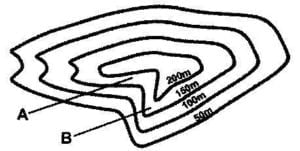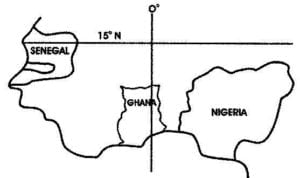BECE Past Questions & Answers – 1997 (SOCIAL STUDIES)

August 1997
SOCIAL STUDIES
SECTION B ESSAY
1 hour
Answer three questions only, choosing one question from each section.
Credit will be given for clarity of expression and orderly presentation of material
All questions carry equal marks
PART I
MAP SKILLS AND ENVIRONMENT
Answer one question only from this part.
1.

(a) On the outline map of West Africa provided, insert the following features: (i) Accra
(ii) Lagos
(iii) River Senegal (iv) River Volta (v) River Niger
(vi) Jos Plateau
2.
(b)
(a)
Mention any two reasons why most rivers in West Africa are not navigable.
How are the following features shown on topographical maps?
(i) Railway
(ii) Marshy area (iii) Court House (iv) Mosque
(v) Market
(vi) Farm
(b) Mention two elements of the weather and the instrument used to measure each of them.
PART II
THE NATIONAL COMMUNITY
Answer one question only from this part
3. Explain any five achievements of Sir Alan Burns in the Gold Coast.
4. (a) Mention five types of timber found in the forests of Ghana.
(b)
Give five reasons that make the timber industry important in Ghana.
PART III
WEST AFRICA, AFRICA AND THE WORLD
Answer one question only from this part
5. Explain five reasons why the Moroccans defeated the Songhai Empire at the battle of Tondibi.
6. Describe five achievements of the Organization of African Unity (OAU) CLICK TO VIEW ANSWERS TO PART 2
SOCIAL STUDIES
SOLUTIONS
SECTION B
ESSAY
PART I
MAP SKILLS AND ENVIRONMENT
Answer one question only from this part.
7.
(a) The following features: (vii) Accra
(viii) Lagos
(ix) River Senegal (x) River Volta (xi) River Niger (xii) Jos Plateau

(b) Reasons why most rivers in West Africa are not navigable.
(i) Shallow depth. Most West African rivers are too shallow for smooth navigation by large boats or ferries
(ii) Trees / tree stumps – A number of West African rivers have trees / tree stumps in them.
This makes it dangerous for boats to travel on them.
(iii) Waterfalls and rapids – Certain West African rivers have waterfalls / rapids, which make transportation on them impossible.
(iv) Winding course. Most West African rivers have winding courses, making them
unsuitable for navigation.
[any two]
8. (a) How the following features are shown on topographical maps
(vii) Railway
(viii) Marshy area
(ix) Court House
(x) Mosque 
(xi) Market
(xii) Farm
(b)
Elements of the weather and the instrument used to measure each of them.
ELEMENT MEASURING INSTRUMENT Rainfall Rain gauge
Wind direction Wind vane
Wind speed Anemometer
Humidity Hygrometer / Wet and Dry bulb
Atmospheric pressure Barometer Temperature Thermometer Cloud Ceilometer
Sunshine Sunshine recorder / sundial
[any two]
PART II
THE NATIONAL COMMUNITY
9. Achievements of Sir Alan Burns in the Gold Coast.
(i) 10-year Development Plan – He drew a ten-year development plan for the Gold Coast
(ii) Income Tax – He introduced the payment of income tax to generate revenue for the development of the country.
(iii) Education – He established many schools and colleges including the Prempeh College at
Kumasi
(iv) Railway Lines – He constructed the railway lines from Awaso to Dunkwa for the transportation of bauxite for export through the Takoradi port.
(v) 1925 Constitution – He led the preparation and introduction of the 1925 constitution of the Gold
Coast, which allowed the inclusion of more Africans in the Legislative and Executive Councils
[any five]
10. (a) Types of timber found in the forests of Ghana.
Odum
Mahogany
Wawa
Sapele
Iroko
Obeche
Walnut
teak
[any five]
(b) Reasons that make the timber industry important in Ghana.
(i) Employment – The timber industry provides employment to several categories of people including chain-saw operators, merchants, saw-mill operators
(ii) Government Revenue – The government obtains revenue from the industry through taxes, levies and royalties.
(iii) Foreign Exchange – The export of timber to other countries provides foreign exchange to the government
(iv) Furniture – Timber is an important raw material for the furniture industry in Ghana
(v) Electrification – Tens of thousands of electric poles used each year by the Electricity
Company of Ghana are made of timber.
(vi) Fishing – Almost all fishermen in Ghana use fishing boats or canoes that are made from timber
(vii) Building and Construction Industry – Timber is used for various things in the building and construction industry, including doors, window frames, ceilings, floors, etc
(viii) Fuel – Timber serves as fuel (firewood / charcoal) for both domestic and industrial
purposes
[any five]
PART III
WEST AFRICA, AFRICA AND THE WORLD
11. Reasons why the Moroccans defeated the Songhai Empire at the battle of Tondibi.
(i) There was a period of drought (famine / lack of sufficient food) in Songhai, which negatively affected the economy, the health and wellbeing of the people of Songhai
(ii) There was also an outbreak of diseases that killed some people and reduced the physical strength
of many.
(iii) The leader of the Moroccan army, Judah Pasher, was very brave, skilful and a good strategist.
(iv) The Songhai strategy, of destroying the desert wells to deprive the Moroccan soldiers of water, did not work, because the sent men were killed.
(v) The Moroccans fought with guns, while the people of Songhai fought with swords, bows and arrows.
(vi) There were divisions within the Songhai state and the army. This made them weak against the
strong and united Moroccans
[any five]
12. Achievements of the Organization of African Unity (OAU)
(i) PEACE, UNITY & SOLIDARITY- It has helped to achieve greater peace, unity and solidarity among the African countries and the peoples of Africa
(ii) INDEPENDENCE – It has assisted many countries in the fight against colonialism and helped them to gain independence
(iii) SOVEREIGNTY – It has helped to defend the sovereignty, territorial integrity and independence of its Member States;
(iv) POLITICAL INTEGRATION – It has accelerated the political integration of the continent, through its general assembly meetings and other avenues.
(v) AFRICAN COMMON POSITIONS – It has promoted and defended African common positions on issues of interest to the continent and its peoples;
(vi) INTERNATIONAL COOPERATION – It has helped to encourage international cooperation with other countries outside the continent.
(vii) DEMOCRACY – It has helped to promote democratic principles, institutions and practice in its member states
(viii) GOOD GOVERNANCE – It has helped to promote popular participation and good governance;
(ix) HUMAN RIGHTS – It has helped to promote and protect human and peoples’ rights
(x) GLOBAL ECONOMY – It has helped to establish the necessary conditions which enable the continent to play its rightful role in the global economy and in international negotiations;
(xi) DEVELOPMENT – It has promoted sustainable development at the economic, social and cultural levels as well as the integration of African economies;
(xii) RACIAL EQUALITY – It helped to abolish the infamous racial segregation (apartheid)
system in South Africa and established racial equality in other countries
(xiii) TRADE / COMMERCE – It has helped to foster good neighbourliness and encouraged trade among African countries [any five]






